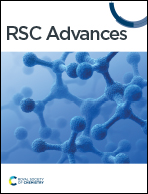Enhancement of photovoltaic performance in ferrocenyl π-extended multi donor–π–acceptor (D–D′–π–A) dyes using chenodeoxycholic acid as a dye co-adsorbent for dye sensitized solar cells†
Abstract
A new set of multi-donor [ferrocene (D) and methoxyphenyl (D′)] conjugated D–D′–π–A based dyes [Fc–(OCH3–Ph)C![[double bond, length as m-dash]](https://www.rsc.org/images/entities/char_e001.gif) CH–CH
CH–CH![[double bond, length as m-dash]](https://www.rsc.org/images/entities/char_e001.gif) CN–R{R
CN–R{R![[double bond, length as m-dash]](https://www.rsc.org/images/entities/char_e001.gif) COOH (1) and C6H4–COOH (2)}] were synthesized as sensitizers for dye-sensitized solar cell (DSSC) applications. These dyes were characterized with the aid of analytical and spectroscopic techniques such as FT-IR, HR-Mass, and 1H and 13C NMR. The thermal stability of the dyes 1 and 2 were investigated using thermogravimetric analysis (TGA) and was found to be stable around 180 °C for dye 1 and 240 °C for dye 2. The electronic absorption spectra for sensitizers display major bands between 400 and 585 nm that could be ascribed to an intramolecular charge transfer (ICT) between the electron donor and acceptor to create an efficient charge separation. The redox behaviour of the dyes was determined by cyclic voltammetry, which revealed the one-electron transfer from the ferrocene to ferrocenium ion (Fe2+ ⇌ Fe3+), and potential was utilized to determine the band gap of the dyes (2.16 eV for 1 and 2.12 eV for 2). Further, the carboxylic anchor dyes 1 and 2 have been utilized as photosensitizers in TiO2-based DSSCs with and without co-adsorbance of chenodeoxycholic acid (CDCA), and the photovoltaic performances were studied. The obtained photovoltaic parameters of dye 2 are open-circuit voltage (Voc) = 0.428 V, short-circuit current density (Jsc) = 0.086 mA cm−2, the fill factor (FF) = 0.432 and the energy efficiencies (η) = 0.015%, the overall power conversion efficiencies were found to be increased in the presence of CDCA as a co-adsorbent. The photosensitizers with the addition of CDCA show higher efficiencies compared to those in the absence of CDCA, which can prevent the formation of aggregation and increased electron injection of the dyes. Among the dyes, the 4-(cyanomethyl) benzoic acid (2) anchor showed higher photovoltaic performance compared with the cyanoacrylic acid (1) anchor due to the introduction of additional π-linkers and acceptor unit, which enables the lowering of the energy barrier and charge recombination process. In addition, the experimentally observed HOMO and LUMO values were in good agreement with the theoretical calculation by the DFT-B3LYP/6-31+G**/LanL2TZf level of theory.
COOH (1) and C6H4–COOH (2)}] were synthesized as sensitizers for dye-sensitized solar cell (DSSC) applications. These dyes were characterized with the aid of analytical and spectroscopic techniques such as FT-IR, HR-Mass, and 1H and 13C NMR. The thermal stability of the dyes 1 and 2 were investigated using thermogravimetric analysis (TGA) and was found to be stable around 180 °C for dye 1 and 240 °C for dye 2. The electronic absorption spectra for sensitizers display major bands between 400 and 585 nm that could be ascribed to an intramolecular charge transfer (ICT) between the electron donor and acceptor to create an efficient charge separation. The redox behaviour of the dyes was determined by cyclic voltammetry, which revealed the one-electron transfer from the ferrocene to ferrocenium ion (Fe2+ ⇌ Fe3+), and potential was utilized to determine the band gap of the dyes (2.16 eV for 1 and 2.12 eV for 2). Further, the carboxylic anchor dyes 1 and 2 have been utilized as photosensitizers in TiO2-based DSSCs with and without co-adsorbance of chenodeoxycholic acid (CDCA), and the photovoltaic performances were studied. The obtained photovoltaic parameters of dye 2 are open-circuit voltage (Voc) = 0.428 V, short-circuit current density (Jsc) = 0.086 mA cm−2, the fill factor (FF) = 0.432 and the energy efficiencies (η) = 0.015%, the overall power conversion efficiencies were found to be increased in the presence of CDCA as a co-adsorbent. The photosensitizers with the addition of CDCA show higher efficiencies compared to those in the absence of CDCA, which can prevent the formation of aggregation and increased electron injection of the dyes. Among the dyes, the 4-(cyanomethyl) benzoic acid (2) anchor showed higher photovoltaic performance compared with the cyanoacrylic acid (1) anchor due to the introduction of additional π-linkers and acceptor unit, which enables the lowering of the energy barrier and charge recombination process. In addition, the experimentally observed HOMO and LUMO values were in good agreement with the theoretical calculation by the DFT-B3LYP/6-31+G**/LanL2TZf level of theory.



 Please wait while we load your content...
Please wait while we load your content...